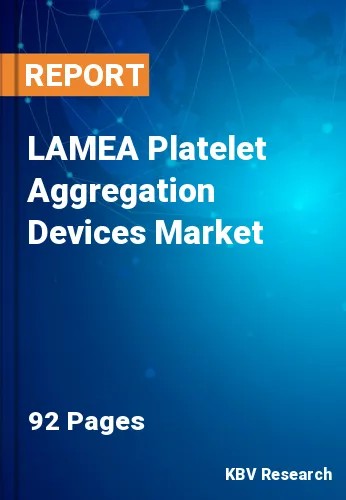The Latin America, Middle East and Africa Platelet Aggregation Devices Market would witness market growth of 7.3% CAGR during the forecast period (2023-2030).
Incorporating neuro-inspired computing enables these devices to engage in more sophisticated interactions. The devices can process information like the complexity of neural networks, leading to nuanced responses and interpretations. Neural networks are known for their adaptability to diverse stimuli, and this characteristic is mirrored in these devices utilizing neuro-inspired computing. These devices can adapt their responses based on the conditions encountered during platelet function assessments.
Furthermore, the incorporation of haptic feedback technology into these devices marks a significant step toward improving user experiences and expanding the applications of these devices. Whether in virtual reality simulations, telepresence scenarios, or medical robotics, haptic feedback enhances the sense of touch, providing a more immersive and realistic interaction with platelet function data. With the ongoing advancement of technology, haptic feedback is positioned to enhance platelet aggregation assessments in hematology by making them more accurate, engaging, and accessible.
Brazil has witnessed strategic government initiatives and investments in the healthcare sector. As per the data provided by the International Trade Administration in 2023, Brazil is one of the largest healthcare sectors in Latin America and spends 9.47% of its GDP on healthcare, representing US$161 billion. Brazil’s Unified Healthcare System (SUS) is the sole provider of health services to approximately 72% of the population. Moreover, Saudi Arabia has witnessed a notable epidemiological shift, with a rising incidence of cardiovascular diseases. According to the Saudi Arabia government, over 30% of Saudi Arabia's adult population (18 years and older) is at risk of developing CVD. In Saudi Arabia, CVD is linked to smoking, eating a diet heavy in fat and poor fiber, and leading a sedentary lifestyle. Hence, growing cardiovascular cases and the expansion of the healthcare sector in LAMEA will propel the demand for these devices in the region.
The Brazil market dominated the LAMEA Platelet Aggregation Devices Market by Country in 2022, and would continue to be a dominant market till 2030; thereby, achieving a market value of $24.3 Million by 2030. The Argentina market is showcasing a CAGR of 8.1% during (2023 - 2030). Additionally, The UAE market would register a CAGR of 6.9% during (2023 - 2030).
Free Valuable Insights: The Worldwide Platelet Aggregation Devices Market is Projected to reach USD 1.1 Billion by 2030, at a CAGR of 5.5%
Based on Product, the market is segmented into Consumables & Accessories, and Systems & Instruments. Based on End-Use, the market is segmented into Research & Academic Institutes, Hospital, and Diagnostic Centers. Based on Application, the market is segmented into Research, and Clinical. Based on countries, the market is segmented into Brazil, Argentina, UAE, Saudi Arabia, South Africa, Nigeria, and Rest of LAMEA.
By Product
By End-Use
By Application
By Country
Our team of dedicated experts can provide you with attractive expansion opportunities for your business.

